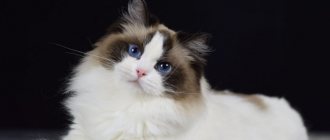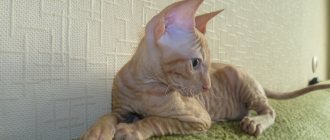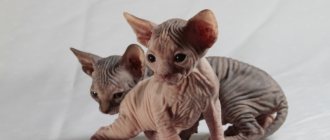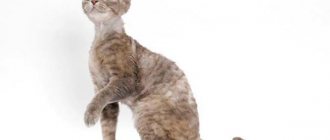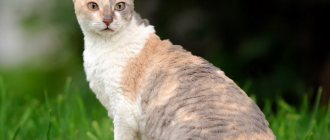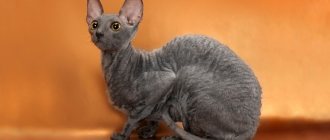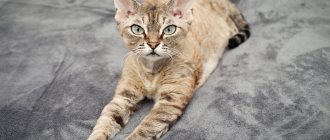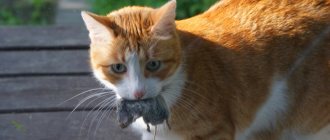History of the German Rex breed
The first mention of the German Rex breed dates back to the 1930s. last century. Its first representative, named Munch, was born from an Angora cat and a Russian blue cat. His curly coat was the result of a genetic mutation. The kitten was given to the Schneider family. The events took place on the territory of Germany (then Prussia) near the city of Königsberg (modern Kaliningrad). This is where the name of the breed comes from (and “Rex” means curly hair).
However, according to official data, the ancestor of the German Rex breed is a cat with wavy hair named Lamchen, which is translated from German as lamb. She was found in 1951 in Berlin near one of the hospitals by doctor Rosa Karpin. She determined that the stray cat's curly fur was the result of a gene mutation (the cat was probably related to Munch). Her kittens attracted the attention of many breeders, and since then the breed has become increasingly popular in Europe.
In the 60s In the 20th century, breeders in Europe and America crossed German Rexes with Cornish Rexes, American and European Shorthair breeds. Already in 1970, German rexes were recognized by the felinological organizations FIFe and WCF, and the first breed standard was adopted. Now these cats participate in exhibitions and are bred along with the Cornish and Devon Rex.
Exterior of a cat
A distinctive feature of the German Rex is its soft, short and curly coat. In this they are very similar to the Devon and Cornish Rex. Of these three varieties, it is the “Germans” that have the most silky and pleasant-to-touch fur.
Herman Rexes stand out for their soft, wavy coat.
Table: breed standard
| Sign | Characteristic |
| Torso | Muscular but graceful body of medium size. The weight of an adult cat is 3 – 5 kg. Well developed chest |
| Head | Proportional to the body. Round shape. Well developed cheekbones and cheeks. The nose is long; when viewed in profile, there is a small depression in the bridge of the nose. Large round eyes, color harmonizes with coat color. The ears are large and widely spaced, wide at the base and tapering towards the end, inactive |
| Limbs | Graceful limbs of medium length. The hind ones are slightly longer than the front ones. Oval shaped paws |
| Tail | Proportional to the body. Cone-shaped. Middle length. With a slightly rounded tip |
| Coat | There is no coarse guard hair, so the coat is soft, wavy and silky. The vibrissae are short and curled. The color can be any, but the standard does not allow those obtained as a result of hybridization (lilac, chocolate, fawn) |
German Rexes have a bright, unusual appearance.
Disqualifying signs:
- lack of fur in some areas;
- body too large;
- skeletal defects;
- malocclusion;
- poorly developed muscles;
- small ears;
- pointed head.
When assessing a cat, first of all, pay attention to its coat: the waviness should be expressed as strongly as possible. The highest scores are given to animals with the best fur characteristics, even if they are inferior to other participants in some way in terms of physique.
Video: colors of the German Rex
Key facts
The German Rex (or Prussian Rex) breed can be safely acquired if there are small children in the family. These are sociable, friendly and patient pets with very soft and pleasant to the touch fur.
Their genes contain a love of hunting, so cats are active, mischievous, but at the same time loving affection and attention - they are always in a great mood, you definitely won’t get bored with them.
Description of the German Rex breed combines German neatness and Russian friendliness, as well as resigned obedience. Patience that turns into endurance and calmness that borders on laziness are the main character traits of the exotic breed.
At the same time, Germans are incredibly responsive and gentle, resourceful and quick-witted, readily involved in any household activity and stick their little nose everywhere. These are incredibly clean animals, capable of keeping the house clean and even tidying up toys, thereby demonstrating affection and extraordinary abilities to their owner.
Here is a brief description of the German Rex breed:
- Country of origin: East Prussia, early 20th century. Mom is a Russian Blue, dad is an Angora cat.
- Character traits - an active, playful, restless cat who will always find something interesting to do in the house. He loves attention and communication, and tries to tell something with his pleasant, insinuating purring.
- Gets along well with dogs and other pets.
- Animals do not need special care, but in winter the cat must be protected from drafts - wool without undercoat is not able to warm the body at low temperatures.
- For the same reason, in winter, the volume of food portions should be increased, which will give the cat more energy for heating.
- With proper maintenance, the life expectancy of the German Rex reaches 17 years. On average, cats live about 15 years.
The Prussian Rex is an “indicator” of mood, he has a great sense of his friend-breeder, and is always ready to support and console him. The animal is even able to relieve headaches: it lies down next to its owner and purrs. If the owner is offended, the cat can defend himself like a real dog.
Character and behavior
The German Rex is very friendly and completely devoid of aggression. It will never harm a child, so families with children can safely have it. He does not choose his owner among family members, but treats everyone equally well. A representative of this breed is very loving and loyal. He quickly becomes attached to a person and shows his love with tenderness and affection. This cat can sit on your lap and purr for hours. He feels loneliness very acutely and cannot stand the absence of people for a long time. He also quite accurately captures the owner’s mood: if he is in a good mood, the cat will be mischievous and cheerful, and if he is sad, he will sit on his lap or simply be nearby.
The German Rex loves to be the center of attention
The German Rex is also characterized by such character traits as playfulness and energy. He will never refuse to play with a ball or other toy. Even if the pet is sterilized or is of advanced age, it remains cheerful and active. These cats radiate positivity and give a good mood to everyone around them. Even if there is no one to play with him, the pet will be able to occupy himself on his own.
It is not advisable to get a cat of this breed if there are already pets in the house, especially dogs. Most likely, she will not be able to get along with them, and conflicts cannot be avoided. The exception is if the animals were kept together from a very early age.
German rexes are also distinguished by their curiosity and desire to explore the world. There is hardly a place in the house where this “robber” could get into. He also loves various houses, boxes, bags and packages. He prefers to hide his toys, just like dogs do. However, they are wary of guests; at first they will be afraid of new people and may hide in a secluded place. In general, German Rexes are very conservative and do not like any changes, be it a trip, a change of place of residence, participation in an exhibition or a visit to the veterinarian.
Representatives of this breed are very smart and clean. They immediately understand how to behave and adhere to the rules of their owners. These cats easily learn to go to the litter box and scratch their claws on a scratching post. They will not damage the furniture, wallpaper, interior items in the house, or mark the territory.
German rexes can be taught funny tricks, as cats pick up everything on the fly
Offspring
From two to seven individuals appear in a litter. They quickly adapt to the world around them. On the eighth day of life they open their eyes, and in the second week they begin to hear.
Recommended reading:
Bombay cat: description and characteristics of the breed
During the first weeks you should pay close attention, as children are not at all independent. It is important to keep your ears and eyes clean at all times. From birth, you need to be taught to trim your nails. Do this carefully, do not scare your pet, wait until he relaxes. Complementary feeding can be started from the sixth week; this can be milk porridge and cottage cheese, as well as dietary meat.
Adorable curly-haired babies become pets from the first minutes. They are cheerful, mischievous, smart. They learn quickly and get used to the tray. Thanks to their curiosity, kittens can explore the hidden corners of their place of residence day and night. They will play and be mischievous all day long. Therefore, from the first days of life, buy toys for them. You will never be bored with them!
Maintenance and care of the German Rex
All rexes are very thermophilic, like sphinxes. These are indoor cats and will not survive outside. During the cold season, they freeze, and it is advisable to put clothes on them. Do not allow your pet to be in a draft.
In winter it is necessary to dress your pet in warm clothes
When deciding to buy a kitten, you should prepare everything you need for it: a soft bed/house, a scratching post, a tray with a spatula, bowls for food and water, toys, hygiene products (shampoo, hair brush, nail clipper).
Caring for a German Rex is no different from caring for a cat of another short-haired breed. You should bathe your cat infrequently - once every 6 months. But if one of your family members has allergies, you can wash it every month or even more often. The fact is that an allergic reaction does not occur to animal fur, but to a special protein that is contained in the cat’s saliva and other biological fluids and is spread throughout the house mainly with the help of wool (hence the myth that there is an allergy to wool). And since the German Rex practically does not shed, the likelihood of unpleasant symptoms is sharply reduced, especially if you wash it more often.
For bathing, you should use a special zoo shampoo. Here are a few suitable options that have proven themselves in the market:
- AVZ "Lesnoy".
- VEDA "Phytoelite" for short-haired cats.
- Rolf Club Shiny.
- CLINY “Nutrition and Shine”.
- Ms. Kiss "Graceful Panther".
Each of the shampoos is designed for short-haired cats and perfectly cleanses the animal’s coat and skin and adds shine to the coat. They are hypoallergenic, which is especially important, and also have a pleasant, mild odor and foam well.
German Rex ears require special care. Once a week you need to inspect their inner surface in order to promptly detect symptoms of diseases. You can remove excess wax from your ears using cotton swabs coated with petroleum jelly or other oil. The cat's eyes should be wiped weekly with cotton pads soaked in boiled water, chamomile infusion or weak tea.
If your pet does not use the scratching post very actively, it is recommended to trim the claws with a nail clipper. This should be done once every 1 - 2 months.
You need to trim your claws correctly: it is important not to touch the pulp, where the nerve endings and blood vessels are located.
Veterinarians do not recommend using anti-scratch pads, because this is a lot of stress for the cat. If you trim your cat's claws as needed, and also train your cat to use a scratching post, you won't have any problems with damaged wallpaper, furniture, or other interior items.
German Rex coat care is simple. It needs to be brushed with a soft brush 1-2 times a week. During the shedding period, you can remove dead undercoat with a furminator (for short-haired cats).
You also need to take care of your Rex's teeth - wipe them daily with a finger wrapped in damp gauze (the easiest option). You can use a special rubber thimble for these purposes. You can also buy toothpaste for cats and a comfortable brush at pet stores. But under no circumstances should you use ordinary paste for people. It should be noted that eating dry food for your pet has a positive effect on dental health, as it constantly cleans teeth of plaque.
You need to brush your cat's teeth daily
Feeding
You can feed your cat either commercially produced food or natural food. Veterinarians do not recommend combining these two feeding methods. The first of them is more convenient and cheaper (and no worse in terms of the quality of the pet’s nutrition, which is important), since few people in the modern world can prepare food for their pet from natural products every day.
If you decide to feed your pet with ready-made food, you should buy food of at least premium and super-premium classes. Best rating based on reviews:
- Royal Canin;
- Hill's;
- Eukanuba;
- Brit Care (but not Premium);
- 1st Choice;
- Eukanuba;
- Almo Nature;
- Purina Pro Plan.
Any food presented contains all the necessary nutrients, vitamins and minerals for the healthy development of a cat, and is also balanced in composition. The basis of the diet is proteins (most often chicken, turkey, lamb), as well as carbohydrates (cereals, vegetables, fruits).
If finances allow, you can feed your pet even more expensive holistic food. These diets contain only high quality ingredients that are suitable for human consumption. Their basis (75 - 90%) is animal protein (chicken, turkey, duck, salmon, etc.). The most popular are Canadian holistic providers Orijen, Acana, Now, Go.
Holistic - the best choice of dry cat food
Each manufacturer produces a whole line of food to meet the needs of any pet. You can choose food based on:
- age of the pet (for kittens, adult cats and elderly cats);
- coat length (for short-haired, long-haired and hairless breeds);
- activity (Indoor - for domestic cats, that is, less active, and Outdoor - for cats with access to the yard, that is, more active);
- characteristics of a particular pet (for sterilized, picky animals, with sensitive digestion, against the formation of hairballs in the stomach, with a tendency to obesity, etc.);
- breed (for cats of a certain breed, for example, Royal Canin food for Persian cats, Sphynx cats, British and Scottish cats);
- health conditions (dietary diets for cats with various diseases).
Premium and super-premium class foods belong to the middle price category (400 g - 250 - 300 rubles, 2 kg - 1200 - 1500 rubles), holistic and medicinal foods are more expensive (230 g - 300 - 350 rubles, 2 kg - 2000 - 2500 rubles).
I do not recommend feeding your cat economy class food (Whiskas, Kitekat, Perfect Fit, Friskies). Their main component is cereals that are useless and reduce the cost of production. There is little animal protein in them (no more than 2 - 4%), and it is of the lowest quality (flour from animal waste, bones and cartilage). Many cats eat them with pleasure, but this is only because the manufacturer has added flavoring chemical additives to them that attract animals. Such food will satisfy hunger, but will not be beneficial and will ultimately cause serious illness and early death of the pet. Based on many reviews, we can conclude that cats that consume economy-class food most often do not live to be 8 years old.
Don't forget about water: your cat needs fresh filtered water in its bowl every day. Tap water contains many harmful substances that are no less dangerous for cats than for humans.
If the owner still decides to feed the pet natural food, the diet should be correctly composed:
- 60% - proteins (more - animal, not plant);
- 30% - carbohydrates;
- 10% - fats.
The basis of your pet’s diet should be the following products:
- lean meat (chicken, turkey, rabbit, beef, veal, lamb) and offal (liver, kidneys, tripe);
- fish - only sea fish (once a week);
- cereals (barley, rice, buckwheat, oats);
- vegetables and fruits (according to the cat’s preferences, exceptions are below);
- fermented milk products (low-fat kefir, cottage cheese);
- raw chicken and quail eggs (once a week);
- milk (allowed for kittens).
Food should not be salted and peppered.
Fresh meat and fish must be frozen for 2 - 3 days before feeding them to your pet. If this is not done, helminth infection may occur. In any case, heat treatment will not be superfluous: both chilled and thawed meat should be cooked.
Do not give to pets:
- sausage, sausages;
- bones (as well as head, neck) and skin;
- any spicy, salty, smoked and fried foods;
- industrial sauces;
- everything sweet and floury;
- from vegetables: eggplant, onion, garlic, radish, radish.
It is advisable to additionally give your pet a vitamin-mineral complex, since natural food does not contain all the micronutrients necessary for a cat.
German rexes love to eat, so it is important for the owner to control the amount of food eaten. This breed is prone to obesity. Food - and this applies to both industrially produced food and natural food - must be dosed and given in portions. Small kittens can be fed 5 - 6 times a day, at the age of 6 months - 3 - 4 times a day, and adult cats - 2 times a day.
The serving size depends on how much the cat weighs. The daily rate can be calculated using the formula: weight x 5%. For example, a cat weighing 5 kg should eat 250 g of food per day. You need 2 times less dry food, since it does not contain moisture. You can always find a table with norms on the packaging of finished food.
Proper nutrition
Herman Rexes are quite picky eaters, so it is advisable to feed them high-quality, balanced, dry food. If the food is natural, the diet must include:
- lean beef meat (raw and boiled);
- poultry fillet (chicken or turkey);
- boiled fish, cleaned of bones;
- chicken or beef offal (lung, heart, liver);
- vegetables and fruits;
- cereals (buckwheat, rice);
- fermented milk products (low-fat yoghurts, cottage cheese, kefir);
- milk should be given with caution after the pet reaches six months of age, otherwise gastrointestinal upset may occur.
Dry and wet food should have a normal shelf life and contain taurine and healthy natural additives. It is prohibited to give:
- tubular poultry and beef bones;
- sweets and baked goods;
- legumes;
- bread;
- food from the table.
Near the bowl of food there must be a container filled with clean, fresh water. In winter, natural food should be higher in calories.
Rex health
In general, German Rexes are in good health. They rarely have genetic diseases. Among the serious pathologies are the following:
- Hypertrophic cardiomyopathy is a pathology in which the wall of the heart ventricle thickens. As a result, its volume decreases and less blood is pumped per cycle. This, in turn, can gradually lead to the development of heart failure. No symptoms of the disease are observed in the initial stages, so this disease is considered insidious, capable of quickly leading to the death of the animal.
- Coagulopathy is a pathology associated with a deficiency of vitamin K in the body. It manifests itself in problems with blood clotting. As a result, the animal may die from bleeding if you do not contact a veterinarian in time.
However, a cat of this breed is susceptible, like all others, to infectious diseases. This is why it is so important to vaccinate your pet annually. In addition, if the cat has access to the outdoors, he can “pick up” parasites. In this regard, it is recommended to regularly treat the animal’s fur with special products.
On average, German rexes live 13 - 15 years, but they can live much longer (up to 20 years) if you feed them high-quality food, get vaccinated on time, and visit the veterinarian every year even in the absence of any symptoms.
Breeding German Rex
If breeding cats is not planned, the animal should be sterilized. The appropriate age for this is 8–12 months, when the animal’s reproductive system is already fully formed. But some breeders also practice earlier sterilization.
The first heat of a female German Rex should be expected at approximately 7 - 8 months. But to breed, you need to wait until she is at least a year old. This is the optimal age when a cat is already able to give birth to healthy offspring.
It is very important to choose the right partner for her. He must be healthy, without hereditary diseases, and also have a good pedigree. It is advisable to pair a female for the first time with a male who has already had a similar experience.
Preliminary preparation of partners is also very important: 30 days before the chosen date, the cat and cat should be dewormed, and after 15 days they should be vaccinated. Since animals can injure each other during mating games, their claws must be trimmed before mating. Pets should not be bathed so that they are attracted to each other by their natural scent.
Most often, the female is brought to the male’s territory and left for 3–4 days. You definitely need to bring everything you need for her: a bed, bowls, a tray. This way the cat will feel freer and more confident. For some time, the partners get used to each other. The cat's covering can occur within a few hours or within a day.
If the mating is successful, pregnancy occurs, which lasts an average of 63 - 65 days. A cat can change - become too affectionate or, conversely, aggressive. Soon the first signs appear - the nipples swell and turn pink. After a month you can already see the growing belly. However, it is not recommended to feel kittens to find out their number; they are very fragile.
A week before giving birth, the cat’s behavior will change: she will become more restless, she will lick herself thoroughly, and her nipples will increase even more. A suitable place for childbirth should be prepared in advance. This could be, for example, a cardboard box. You need to put a clean cloth in it.
Most often, pregnancy and childbirth proceed well. But during childbirth, complications may arise due to a too narrow pelvis, large kittens, and weak uterine contractions. If your cat is unable to give birth to a kitten, you should immediately call a veterinarian. If this is your cat's first pregnancy, be sure to monitor her and be prepared to help her if necessary.
The cat feeds the kittens milk for a month
It is recommended to send babies to new families when they are 2 months old. During this time, they feed on their mother's milk and learn simple skills from her.
Buying a kitten
It is difficult to buy a German Rex kitten in Russia. If this is unimportant, it is better to choose a Cornish Rex or Devon Rex. There are many nurseries that breed cats of these breeds.
However, if you want a “German”, you will have to negotiate with European breeders. It will cost from 15 to 50 thousand rubles. Also, certain difficulties may arise when transporting an animal.
It is very difficult to distinguish a German Rex kitten from a Devon Rex. Both breeds have a rounded, short head, but the Devons have a heart-shaped head, while the Germans have a slightly more elongated head. The ears of both breeds are large and wide. There are differences in the quality of wool: Devons have hard guard hairs, while Germans do not, so it is very soft. However, the coat (like the waves) is finally formed only by 1 - 1.5 years, and in kittens the fur can be completely straight or even fall out completely. The differences between them are so minimal that the authoritative organization CFA, as already mentioned, considers them to be the same breed.
Cornish Rex dogs are quite easy to recognize: they have an elongated muzzle and a wedge-shaped head. There are also differences in the shape of the ears: they are narrower and more elongated. Cornish Rex eyes are almond-shaped rather than round.
Tips for choosing a kitten
It is quite difficult to buy a German Rex in the Russian Federation. Most likely, for show-class animals you will have to turn to European breeders and pay a lot of money. Certain difficulties will arise with transporting the animal to its future owner.
The breed is very similar to the Devon Rex, but there are differences. An elongated and rounded head, wide and large ears with very soft fluff on the back, wide open and round eyes that harmonize with the color will help to distinguish a German Rex kitten from similar breeds with curly hair.
No less attention should be paid to the purity of the pedigree - for this, breeders present metrics and certificates. The animal's father and mother must be completely healthy, and the kitten must be active, cheerful, moderately well-fed, with clean eyes and ears, a beautiful wavy coat and fully vaccinated, which should be reflected in the veterinary passport.
If you are a beginner breeder, when choosing a German Rex kitten, seek help from a professional nursery specialist. He will help you choose a purebred baby and give you tips on completing the paperwork.

